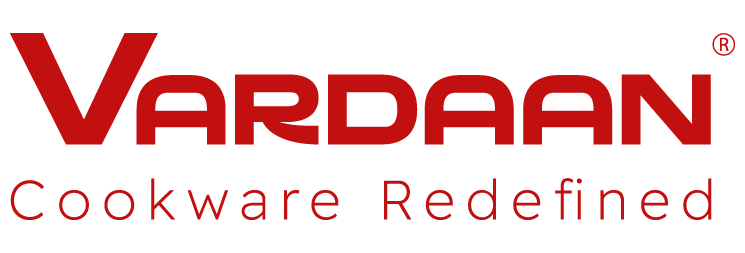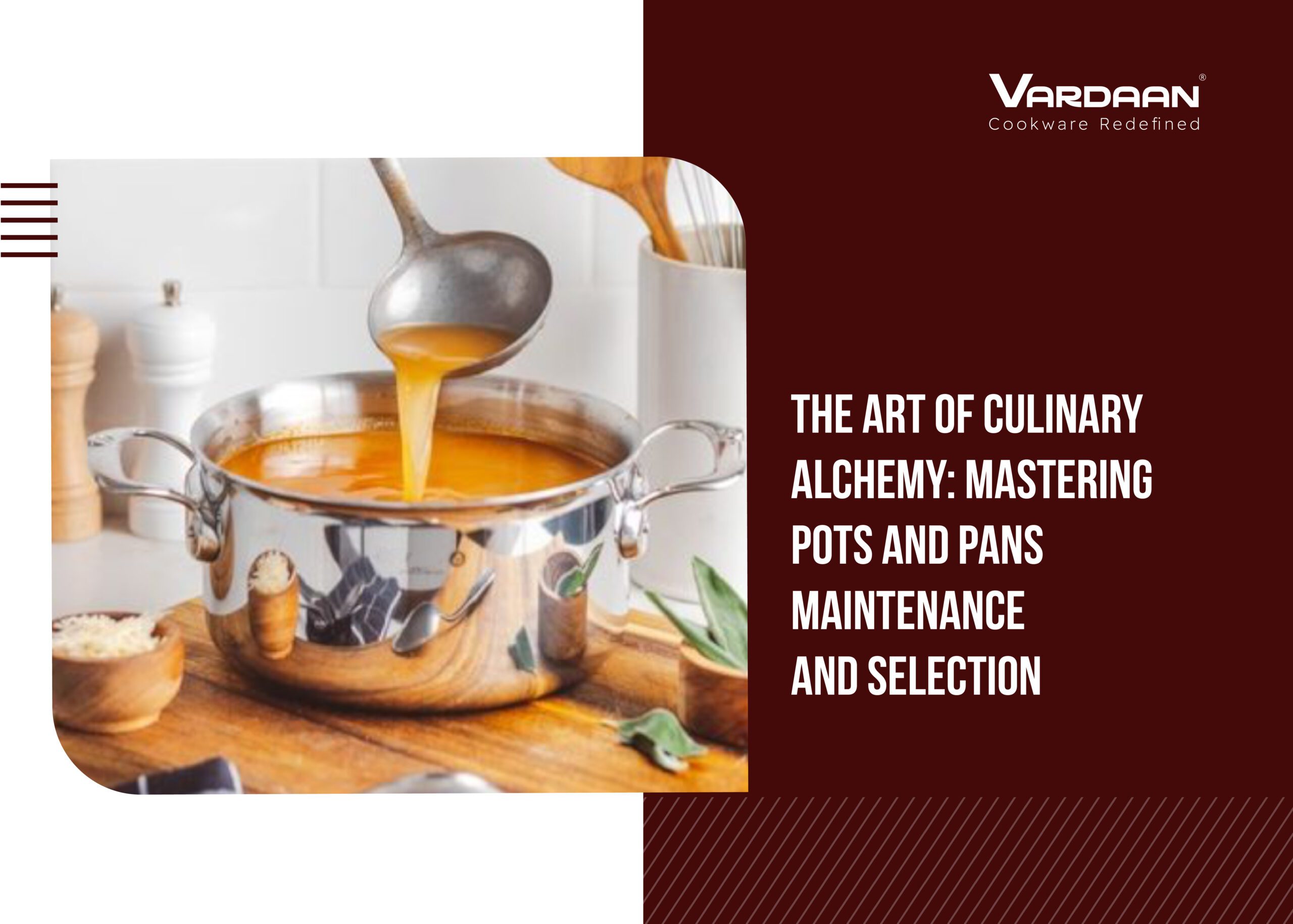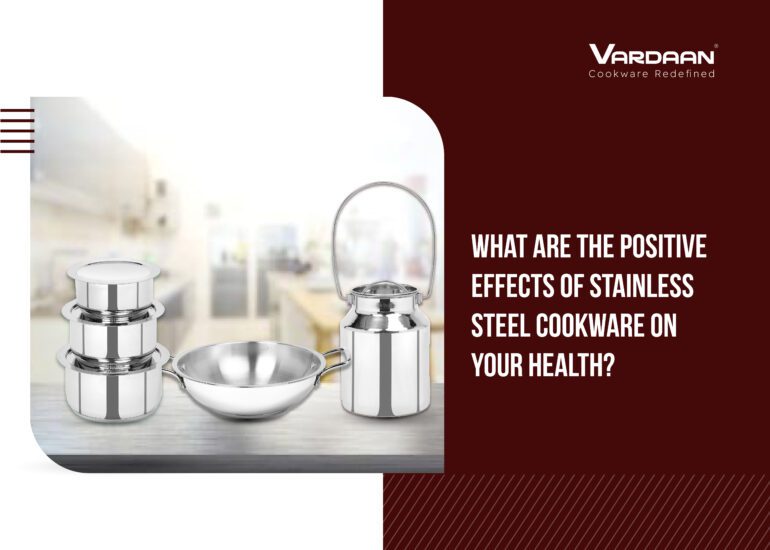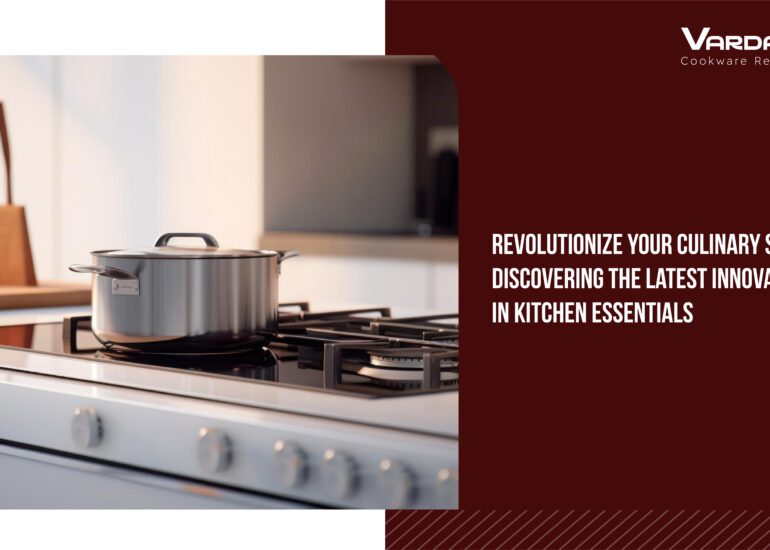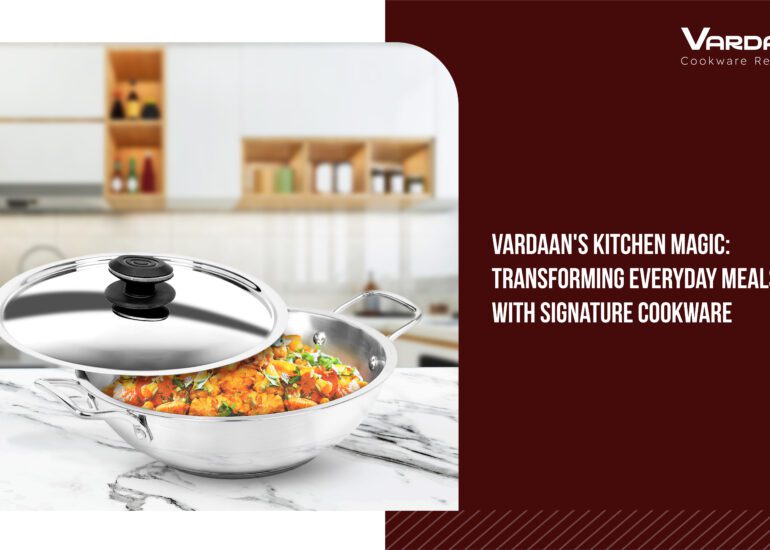In the realm of culinary exploration, the term “culinary alchemy” captures the transformative magic that occurs when skilled hands wield quality pots and pans. Culinary alchemy is not just about the precise combination of ingredients; it’s an intricate dance between the cook’s creativity and the cookware’s capabilities. At the heart of this alchemical process lies the versatile and reliable stainless steel cookware, a fundamental player in the kitchen symphony. The transformative nature of cooking, akin to alchemy, unfolds as ingredients meld, flavors intensify, and textures evolve. Quality cookware acts as the conductor, orchestrating this symphony of tastes and aromas. Stainless steel, with its durability, even heat distribution, and resistance to corrosion, becomes the canvas for culinary creation. As we delve into the art of culinary alchemy, we unravel the secrets of stainless steel cookware versatility, understanding how it not only withstands the heat of the kitchen but also contributes to the enchantment of every dish. Join us on a journey where pots and pans are not just utensils but essential elements in the alchemical equation of culinary mastery.
Cookware Material Comparison
| MATERIAL | STAINLESS STEEL | CAST-IRON | NON STICK | COPPER |
| Durability | Highly durable and resistant to rust and corrosion. | Extremely durable, can last for generations with care. | Durability depends on the coating; may wear over time. | Durable but can tarnish; requires maintenance. |
| Heat Retention | Good heat retention and even heating. | Excellent heat retention but slower to heat up. | Excellent heat conductivity; heats up quickly. | Exceptional heat conductivity and precise temperature control. |
| Versatility | Versatile for various cooking techniques and styles. | Suitable for slow cooking, frying, and baking. | Ideal for low-fat cooking; may not be suitable for high-heat methods. | Versatile for precise cooking needs; commonly used in professional kitchens. |
| Maintenance | Relatively easy to clean and maintain. | Requires seasoning and proper maintenance to prevent rust. | Easy to clean but can scratch; requires careful utensils. | Requires regular polishing to maintain appearance. |
| Price Range | Moderate to high depending on quality. | Moderate; initial investment pays off in longevity. | Affordable to moderate; price varies with brand and features. | High-end; often more expensive than other materials. |
Considerations for Selection:
- Cooking Style:
- Stainless steel for versatile cooking.
- Cast iron for slow-cooking and baking.
- Non-stick for low-fat cooking.
- Copper for precise temperature control.
- Durability Preferences:
- Stainless steel for long-lasting durability.
- Cast iron for generational use with proper care.
- Non-stick for moderate durability.
- Copper for durable but tarnish-prone cookware.
- Heat Conductivity:
- Stainless steel for even heating.
- Cast iron for excellent heat retention.
- Non-stick for quick heating.
- Copper for exceptional heat conductivity.
- Maintenance Effort:
- Stainless steel for easy maintenance.
- Cast iron for regular seasoning.
- Non-stick for careful cleaning.
- Copper for regular polishing.
- Budget Considerations:
- Stainless steel for a moderate to high budget.
- Cast iron for a moderate budget.
- Non-stick for an affordable to moderate budget.
- Copper for a high-end budget.
Choosing the right cookware involves considering these factors to align with individual cooking preferences and requirements.
Pots and Pans Maintenance Tips: A Comprehensive Guide
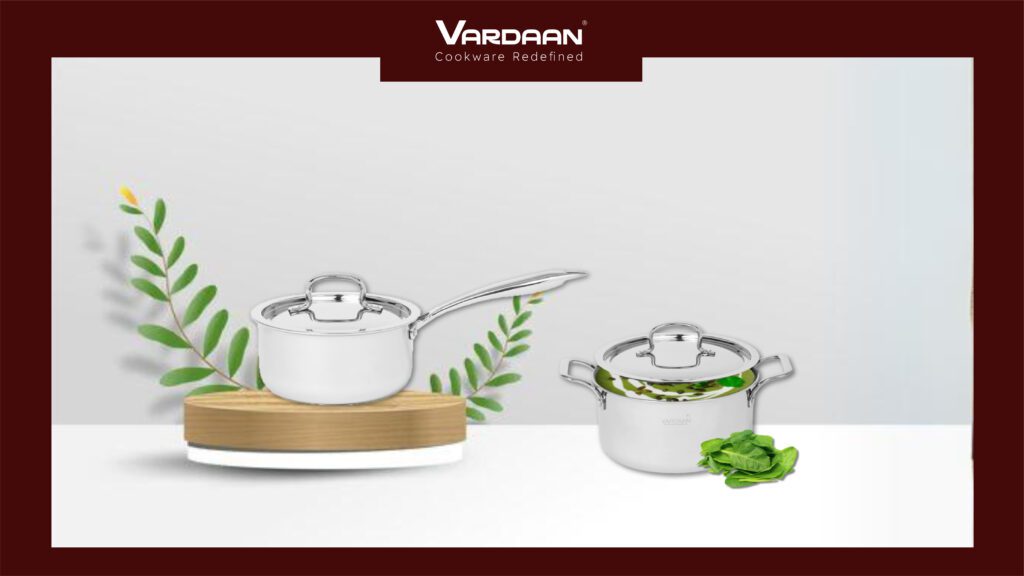
Proper Cleaning Techniques for Various Cookware Materials:
Maintaining the longevity of your cookware begins with proper cleaning. Follow these guidelines based on different materials:
- Stainless Steel:
- Use mild soapy water and a soft sponge.
- For stubborn stains, a mixture of vinegar and baking soda can be effective.
- Cast Iron:
- Avoid using soap to preserve the seasoned coating.
- Scrub with a brush or salt to remove stuck-on food.
- Dry thoroughly and rub with a thin layer of oil to prevent rust.
- Non-Stick:
- Use a gentle dishwashing detergent and a soft cloth.
- Avoid metal utensils to prevent scratching the non-stick coating.
- Handwashing is recommended to maintain the non-stick surface.
Seasoning and Caring for Cast Iron Pans:
Cast iron pans require special attention to maintain their seasoned coating and prevent rust:
- Seasoning:
- Apply a thin layer of oil (vegetable or flaxseed) to the pan’s surface.
- Heat in the oven upside down to allow excess oil to drip off.
- Daily Care:
- Avoid using soap; if necessary, use minimal amounts.
- Dry thoroughly after each use to prevent rust.
- Rust Removal:
- If rust appears, scrub the affected area with steel wool.
- Re-season the pan to restore its protective coating.
Tips for Preserving Non-Stick Surfaces:
Preserving the non-stick coating is essential for effective cooking and easy cleaning:
- Use Wooden or Silicone Utensils:
- Prevent scratches by using utensils that won’t damage the non-stick surface.
- Avoid High Heat:
- Excessive heat can damage non-stick coatings, so cook at medium temperatures.
- Handwashing Recommended:
- While some non-stick cookware is labeled as dishwasher-safe, handwashing is gentler on the coating.
- Store Carefully:
- Avoid stacking non-stick pans to prevent scratching.
By following these maintenance tips, you ensure the longevity of your cookware, whether it’s stainless steel, cast iron, or non-stick, contributing to a lasting and efficient kitchen experience. For more insights on selecting the right cookware set, refer to our Cookware Set Selection Guide https://vardaancookware.com/products/ .
Unlocking Culinary Hacks: Maximizing Stainless Steel Cookware Versatility
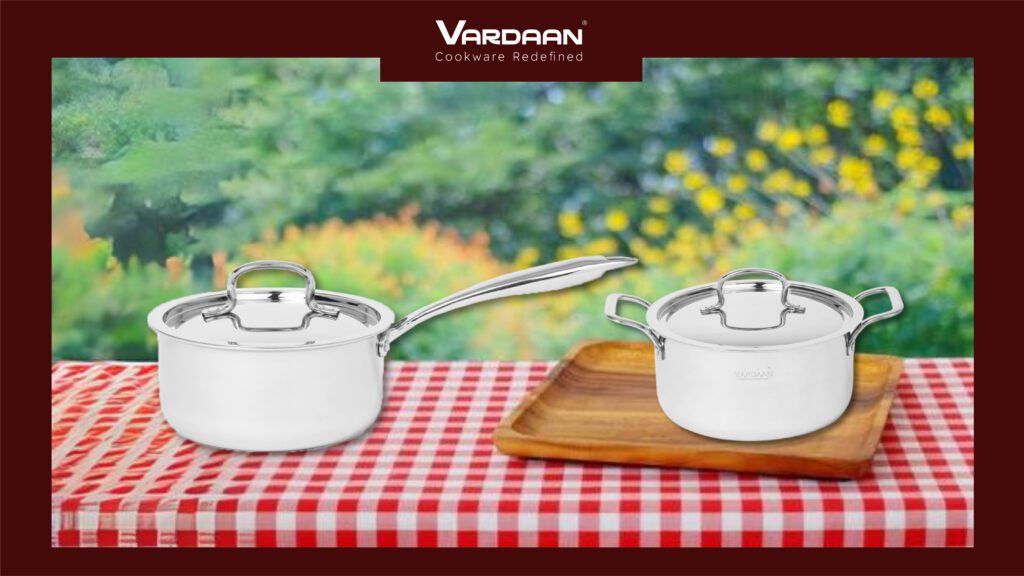
Embrace the full potential of your stainless steel cookware with these innovative hacks that go beyond traditional cooking:
- Baking Pan Substitute:
- Turn your deep stainless steel skillet into a baking pan for casseroles or layered desserts.
- Steamer Setup:
- Transform a deep pot into a steamer by placing a heat-resistant colander or steaming basket above simmering water.
- Double Boiler Trick:
- Create a makeshift double boiler by placing a heatproof bowl over a pot of simmering water for delicate tasks like melting chocolate.
- Lid as Splatter Guard:
- Use a slightly tilted lid to prevent stovetop splatters while simmering or frying.
- Impromptu Roasting Rack:
- Elevate roasts or poultry by crumpling aluminum foil into a coil and placing it in the bottom of the pan.
- Oven-Safe Handle Hack:
- Make any pan oven-safe by wrapping the handle in a few layers of damp cloth and securing with foil before baking.
- Homemade Smoker Setup:
- Turn a deep pan into a stovetop smoker by lining the bottom with wood chips, placing a rack above, and covering tightly with foil.
- Grill Pan Alternatives:
- Create grill marks on indoor-cooked steaks by pressing the bottom of another heated stainless steel pan onto the meat.
- Pot Lid as Cooling Rack:
- Invert a pot lid to use as a cooling rack for freshly baked cookies or cakes.
- Clever Cookie Cutter:
- Use the rim of a small stainless steel pot as a circular cookie cutter for perfectly shaped treats.
By exploring these versatile hacks, you not only enhance the functionality of your stainless steel cookware but also infuse creativity into your culinary adventures. For more maintenance tips and insights into cookware versatility, check out our other blog on Pots and Pans Maintenance Tips – https://vardaancookware.com/the-secret-to-long-lasting-shine-stainless-steel-cookware-maintenance-tips/
Matching Cookware to Culinary Demands: Unleashing Stainless Steel Versatility
Unlock the true potential of your stainless steel cookware by matching it with the specific demands of various cuisines. Consider these key points for a versatile and tailored cooking experience:
- Wok Adaptation:
- A deep stainless steel skillet serves as an excellent substitute for a wok, allowing you to stir-fry with ease.
- Sauté Mastery:
- Opt for a wide stainless steel sauté pan for even heat distribution, perfect for dishes that require quick and high-heat cooking.
- Braising Brilliance:
- Elevate your braising game with a large and deep stainless steel pot, ideal for slow-cooking meats and hearty stews.
- Saucepan Precision:
- Choose a stainless steel saucepan for precise temperature control when crafting delicate sauces or reheating leftovers.
- Pasta Pot Performance:
- Invest in a spacious stainless steel pasta pot with a strainer insert for effortless pasta cooking and draining.
- Frying Pan Flexibility:
- Utilize a quality stainless steel frying pan for versatile frying, searing, and browning tasks.
- Grilling Greatness:
- Achieve grill-like results by using a ridged stainless steel grill pan for indoor grilling with distinct char marks.
- Soup Stock Essential:
- Embrace a stainless steel stockpot for crafting flavorful soups, broths, or boiling large batches of grains.
- Steamer Superiority:
- Opt for a deep stainless steel pot with a steamer insert to unlock the potential of healthy and flavorful steamed dishes.
Tailoring your cookware to specific culinary demands ensures optimal performance and enhances the quality of your dishes. Discover the diverse capabilities of stainless steel cookware for a culinary journey filled with versatility. For more insights into stainless steel cookware, explore our https://vardaancookware.com/products/ for Stainless Steel Cookware Versatility.
Cookware Set Selection Guide: Investing in Quality for Culinary Excellence
Investing in quality cookware is a significant decision that can profoundly impact your culinary experience. Consider the following insights on when and why to invest in top-notch cookware, along with tips for building a versatile collection gradually:
- When to Invest:
- Aspiring Home Chefs: If you’re passionate about cooking and see it as a long-term hobby, quality cookware is a worthwhile investment.
- Moving to a New Home: When establishing a new kitchen, consider investing in quality cookware as a foundational element for your culinary space.
- Celebratory Milestones: Special occasions like weddings or significant life events provide an excellent opportunity to invest in durable and lasting cookware.
- Why Quality Matters:
- Durability and Longevity: Quality cookware is built to last, ensuring durability and longevity even with regular use.
- Even Heat Distribution: High-quality materials provide even heat distribution, preventing hotspots and ensuring consistent cooking results.
- Versatility: Premium cookware often comes with versatile features, allowing you to perform a variety of cooking techniques with a single piece.
- Improved Cooking Performance: Quality cookware enhances your cooking skills and allows you to achieve professional-level results in your dishes.
- Tips for Gradually Building a Collection:
- Start with Essentials: Begin with essential pieces like a quality skillet, saucepan, and stock pot before expanding your collection.
- Consider Multi-Purpose Pieces: Opt for cookware that serves multiple purposes, offering versatility and functionality.
- Gradual Upgrades: Instead of buying a complete set at once, consider upgrading individual pieces over time as your budget allows.
- Research and Compare: Before purchasing, research different brands and materials to make informed decisions based on your cooking needs.
Investing in quality cookware is an investment in your culinary journey. By understanding when and why to invest and adopting a gradual approach, you can build a versatile collection that elevates your cooking experience.
Pots and Pans Maintenance Tips: Tackling Common Challenges
Maintaining your cookware’s pristine condition is crucial for optimal performance and longevity. Address common problems with these quick fixes and preventive measures:
- Sticking Issues:
- Quick Fix: Use a gentle abrasive cleaner or a mixture of baking soda and water to remove stuck-on food.
- Preventive Measure: Season cast iron and carbon steel pans regularly to create a natural non-stick surface.
- Discoloration:
- Quick Fix: Restore shine to stainless steel by boiling a mixture of water and vinegar in the pan.
- Preventive Measure: Avoid high heat for prolonged periods, and promptly clean acidic substances to prevent discoloration.
- Warping Concerns:
- Quick Fix: Place the warped pan on a flat surface and gently press to restore shape.
- Preventive Measure: Avoid rapid temperature changes, such as placing hot cookware in cold water.
- Burnt Residue:
- Quick Fix: Soak the pan in warm, soapy water and scrub gently with a non-abrasive sponge.
- Preventive Measure: Control cooking temperatures and avoid leaving empty pans on high heat.
- Rust Development:
- Quick Fix: Use a scrubber and a mixture of baking soda and water to remove rust.
- Preventive Measure: Ensure thorough drying after washing, and season cast iron pans regularly.
- Scratching Dilemma:
- Quick Fix: Polish scratches in stainless steel with a non-abrasive cleaner.
- Preventive Measure: Use wooden or silicone utensils to prevent scratches, especially in non-stick pans.
- Dull Appearance:
- Quick Fix: Polish stainless steel surfaces with a mixture of olive oil and baking soda.
- Preventive Measure: Regularly clean and polish to maintain a glossy finish.
Adopting these quick fixes and preventive measures ensures that your pots and pans stay in top-notch condition, providing you with reliable and consistent cooking performance.
Stainless Steel Cookware Versatility: Breathing Life Back Into Neglected Pots and Pans
Reviving neglected pots and pans is an art, and sustainable approaches play a key role in extending their lifespan. Here are techniques to bring life back to your cookware while maintaining a sustainable approach:
- Deep Cleaning Rituals:
- Technique: Soak neglected stainless steel cookware in a mixture of warm water and baking soda, then scrub with a non-abrasive pad for a thorough clean.
- Sustainability Aspect: Avoid harsh chemical cleaners, opting for eco-friendly alternatives to minimize environmental impact.
- Rejuvenating Stainless Steel Shine:
- Technique: Polish dull stainless steel surfaces with a blend of olive oil and baking soda, restoring its natural shine.
- Sustainability Aspect: Utilize natural ingredients, reducing reliance on commercial stainless steel cleaners.
- Cast Iron Restoration:
- Technique: Remove rust from neglected cast iron pans by scrubbing with a mixture of baking soda and water, followed by re-seasoning.
- Sustainability Aspect: Embrace the longevity of cast iron, reducing the need for frequent replacements.
- Wooden Utensil TLC:
- Technique: Sand down and oil wooden utensils to rejuvenate their appearance and maintain functionality.
- Sustainability Aspect: Extend the life of wooden utensils, reducing the environmental impact of frequent replacements.
- Non-Stick Pan Resilience:
- Technique: Gently scrub neglected non-stick pans with a mixture of mild detergent and warm water to preserve the coating.
- Sustainability Aspect: Prolong the life of non-stick pans, minimizing the disposal of cookware with worn-out coatings.
- Scratch Prevention Measures:
- Technique: Implement careful utensil usage to prevent scratches on stainless steel surfaces, maintaining their sleek appearance.
- Sustainability Aspect: Reduce the need for replacements by preserving the aesthetic and functional qualities of cookware.
- Regular Seasoning for Longevity:
- Technique: Season cast iron and carbon steel pans regularly to maintain a natural non-stick surface and prevent rust.
- Sustainability Aspect: Promote the sustainability of these materials by extending their useful life.
By adopting these techniques and sustainable practices, you not only breathe life back into neglected pots and pans but also contribute to a more environmentally conscious approach to cookware maintenance. Explore the versatility of stainless steel cookware and discover sustainable ways to care for your pots and pans in our Stainless Steel Cookware Versatility https://vardaancookware.com/recipes/ and Pots and Pans Maintenance Tips guides https://vardaancookware.com/the-secret-to-long-lasting-shine-stainless-steel-cookware-maintenance-tips/ linked here.
Stainless Steel Cookware Versatility: Exploring the Future of Culinary Tools
As we delve into the future of culinary tools, emerging technologies in cookware design are shaping the way we approach cooking. The evolution of stainless steel cookware is at the forefront of this culinary transformation:
- Smart Cooking Surfaces:
- Exploration: Integration of smart technologies into stainless steel surfaces for precise temperature control and cooking assistance.
- Anticipation: Anticipate cookware that communicates with smart kitchen devices, enhancing the overall cooking experience.
- Advanced Materials and Coatings:
- Exploration: Development of advanced materials and coatings to enhance durability, non-stick properties, and resistance to wear.
- Anticipation: Expect cookware that surpasses current standards, offering improved performance and longevity.
- Multi-Functional Designs:
- Exploration: Innovations in multi-functional cookware designs, catering to diverse cooking styles and techniques.
- Anticipation: Look forward to versatile cookware that adapts to various culinary needs, streamlining kitchen tasks.
- Environmental Sustainability:
- Exploration: Integration of sustainable materials and production methods for eco-friendly cookware options.
- Anticipation: Future stainless steel cookware is likely to align with environmentally conscious practices, reducing its ecological footprint.
- Enhanced Heating Technologies:
- Exploration: Research into advanced heating technologies for more efficient and even heat distribution.
- Anticipation: Expect cookware that optimizes energy use, leading to quicker and more precise cooking.
- Customizable and Modular Cookware:
- Exploration: Customizable features and modular components for personalized cooking experiences.
- Anticipation: Imagine cookware that adapts to individual preferences, providing a tailored approach to culinary tasks.
- Incorporation of Artificial Intelligence (AI):
- Exploration: Experimentation with AI algorithms for predictive cooking, recipe recommendations, and automated adjustments.
- Anticipation: Envision cookware that learns and evolves with your cooking style, offering seamless assistance in the kitchen.
The future of culinary tools, particularly stainless steel cookware, holds exciting possibilities as technology continues to advance.
Conclusion
Stainless Steel Cookware Versatility: A Culinary Journey of Innovation and Exploration
In the realm of culinary alchemy, where pots and pans transform ingredients into delectable creations, maintaining and selecting the right cookware is paramount. Our exploration of Stainless Steel Cookware Versatility has unraveled the secrets to preserving and rejuvenating your culinary companions. Remember, the artistry lies not only in the selection but also in the care bestowed upon these kitchen essentials.
From the enduring allure of stainless steel to the ancient charm of cast iron, we’ve delved into diverse materials and their roles in crafting culinary masterpieces. Our guide has offered insights into proper maintenance rituals, innovative uses, and the futuristic landscape of cookware technologies. As you embark on your culinary journey, we encourage you to embrace a mindful and creative approach. Experiment with the versatility of your pots and pans, infuse your cooking with passion and savor the joys of culinary exploration. For a curated selection of high-quality cookware that stands the test of time, visit Vardaan Cookware. Elevate your cooking experience, and let your pots and pans become the trusted companions in your culinary odyssey.
